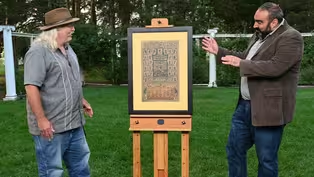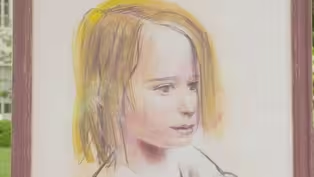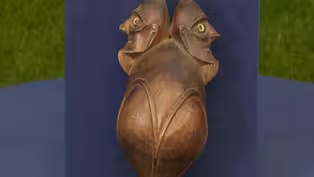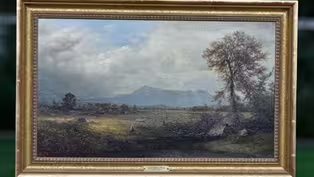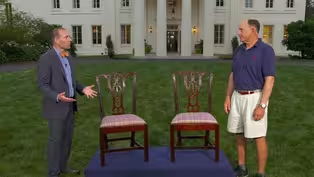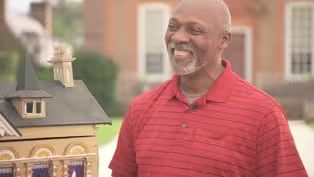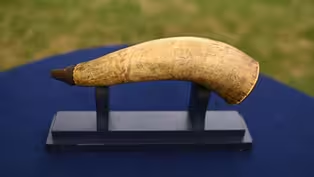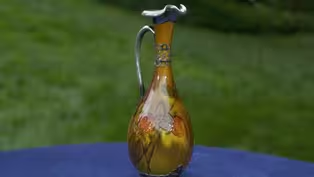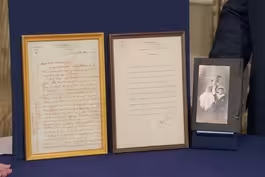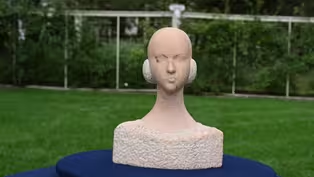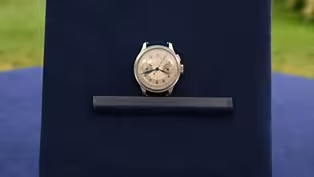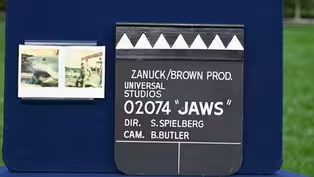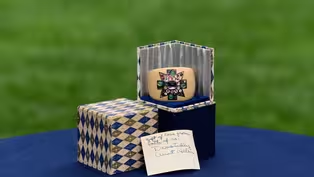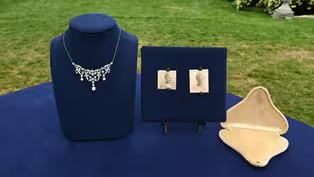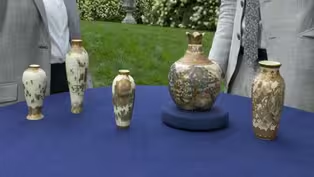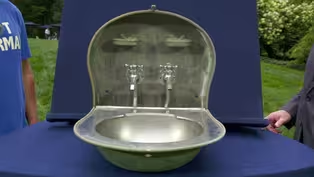
Wadsworth Mansion, Hour 1
Season 26 Episode 1 | 52m 24sVideo has Closed Captions
Season 26 kicks off with captivating Connecticut treasures including a $150K surprise!
Season 26 kicks off with captivating Connecticut treasures at the Wadsworth Mansion, including a Helen Hayes Verdura for Chanel cuff bracelet, a 1917 Boston Red Sox calendar and a 1904 Gandhi handwritten letter. Which is valued at $150,000?
Problems playing video? | Closed Captioning Feedback
Problems playing video? | Closed Captioning Feedback
Funding for ANTIQUES ROADSHOW is provided by Ancestry and American Cruise Lines. Additional funding is provided by public television viewers.

Wadsworth Mansion, Hour 1
Season 26 Episode 1 | 52m 24sVideo has Closed Captions
Season 26 kicks off with captivating Connecticut treasures at the Wadsworth Mansion, including a Helen Hayes Verdura for Chanel cuff bracelet, a 1917 Boston Red Sox calendar and a 1904 Gandhi handwritten letter. Which is valued at $150,000?
Problems playing video? | Closed Captioning Feedback
How to Watch Antiques Roadshow
Antiques Roadshow is available to stream on pbs.org and the free PBS App, available on iPhone, Apple TV, Android TV, Android smartphones, Amazon Fire TV, Amazon Fire Tablet, Roku, Samsung Smart TV, and Vizio.
Buy Now
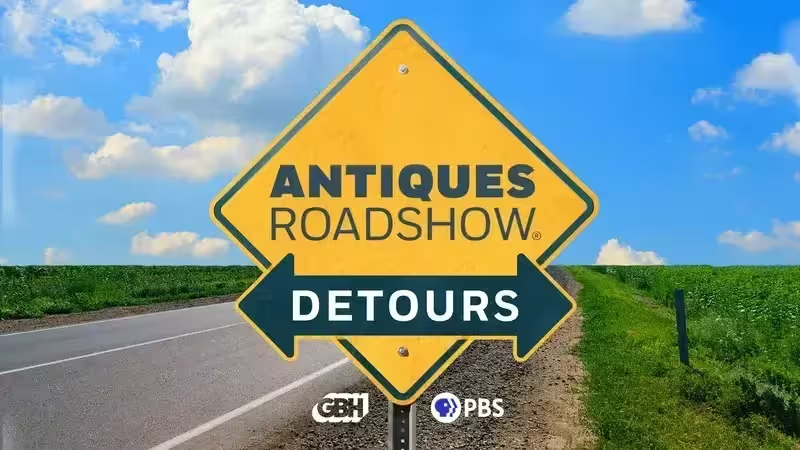
ANTIQUES ROADSHOW DETOURS
Ever wondered what happens to the treasures featured on America’s beloved ANTIQUES ROADSHOW after the cameras leave town? Host Adam Monahan tracks down the juicy afterlives of your favorite finds from PBS’s hit series.Providing Support for PBS.org
Learn Moreabout PBS online sponsorship♪ ♪ CORAL PEÑA: "Antiques Roadshow" is back on the road, kicking off our 26th season and unearthing treasures at Wadsworth Mansion in Connecticut.
WOMAN: And to think it's been to my third-grade show-and-tell class.
(laughs) Did you hear that?
(laughs) ♪ ♪ PEÑA: Wadsworth Mansion at Long Hill in Connecticut was the grandest home in Middletown when it was completed in 1911.
It was originally the country summer residence of Colonel Clarence S. Wadsworth, Katharine Hubbard Wadsworth, and their two sons.
Katharine's family had roots in the area, and several years after the couple married in 1897, the Wadsworths began to carefully plan their 500-acre estate, building this elegant 20,000-square-foot home.
Wadsworth, a colonel in the New York National Guard and a major in the First Company Governor's Foot Guard of Connecticut, was also a zealous conservationist who oversaw every detail of his estate's development.
♪ ♪ Today, "Roadshow" is spread out across the sprawling lawn and among the gorgeous trees that Colonel Wadsworth planted, nurtured, and protected.
Curiosity has been growing about the treasures that have come in, as our guests eagerly await their appraisals, so let's get started.
MAN: It's a 1917 baseball calendar.
I found it online.
It was at least ten years ago.
Maybe, maybe longer than that.
Mm-hmm.
And they said it was real.
I didn't think it was really real.
It was found on a back of a door in a, a barn.
And if you know anything about the Red Sox, they won in 1915 and 1916, as indicated on the calendar, and I thought it was a really cool old, old piece.
I'm from Massachusetts, so I'm a Red Sox fan.
So what we have here is a promotional calendar for Bunker Hill Breweries.
Mm-hmm.
For PB, Purest and Best Ale.
Yeah.
And, uh, it features the Boston Red Sox team.
What makes this calendar very special is, as you said, it's kind of commemorating the 1915-1916 championships.
We have several great players of the era.
Mm-hmm.
Right here in the middle is Harry Hooper.
Hall of Famer, actually.
But this team, 1917, had a great left-handed pitcher, and his name was Babe Ruth.
That's right.
That's what makes this very special.
Oh.
Because there's a, a real desire for anything early in Babe Ruth's career.
And here he is as a young kid, he's only 22 years old.
Oh, yeah.
Yeah, 1917 was a great year for him.
He won 24 games as a pitcher.
Yeah.
But he also hit .325, which was, I think, fourth-best in the American League that year.
Wow.
1917 is the last year he was a great pitcher.
Mm-hmm.
By 1918, he'd started to convert into the outfield.
So this was his last hurrah as, uh, as this great lefty.
Yeah.
I mean, he would have been a Hall of Famer as a pitcher.
What did you pay for this calendar, if you don't mind me asking?
Well...
It was a little more than I wanted to spend at the time.
I, I remember it around $200, $250.
And then it cost me close to that to frame it.
At the time, I thought it might be worth $500.
Well, baseball calendars are something that you'd see back then, but I've never seen this one before, and neither have my colleagues.
Bunker Hill Brewery actually went out of business in 1918.
Oh, really?
So this was one of the last promotional things they did.
Condition, there are some issues, but again, it's a hundred and, you know... Three years old, yeah.
...three years old, at least.
Yeah, right-- because it's an early Ruth piece, because nobody's ever seen it before-- it's also really big-- I spoke to several of my colleagues.
We all agree, at auction, we'd estimate this at $20,000 to $30,000.
Really?
Yeah.
(exhales) 20?
Yeah, $20,000 to $30,000 To 30,000... Auction estimate.
...dollars.
Yeah, yeah.
It's a spectacular early Babe Ruth piece.
That's what makes it so special, Yes.
How much did you say again?
(laughs) I said at $20,000 to $30,000.
Yeah.
(laughs) (chuckles) Did you hear that?
$20,000 to $30,000!
WOMAN: Very good!
(laughing) (exhales) Yeah.
Wow.
♪ ♪ WOMAN: This belonged to my grandmother.
Um, it was given to her husband by his mother.
Um, it had been left in trust from Nellie Bonaparte, and now it belongs to my mother.
I really don't know anything about it.
I wasn't sure if it was the original box, honestly.
Okay.
I can tell you it's absolutely the original box.
The geometry of the necklace matches the geometry of the box.
It does, okay.
Howard and Company is mostly known for silver.
They're a New York firm that opened in 1866.
Joseph Howard had started in the jewelry business at the age of 14.
Huh.
Joined Tiffany and Company in '53, and in 1866, decided to become his competitor.
He was making enough money that, in 1874, he can open a shop in Newport, Rhode Island...
Okay.
...and at some point, a shop in Paris.
Wow.
So Nellie Bonaparte was among the wealthy.
They were sort of mingling in the Gilded Age in New York, 1870 to 1909.
You have two photographs here.
Honestly, I'm not quite sure who they are of, but in one photograph, it looks to me like she is wearing this necklace, and in the second photograph, I think she's wearing pieces from the necklace separately, but I'm not sure.
You feel that they're all part of the original configuration of this necklace?
I do.
Well, I'm here to say that they were not.
(laughs): Okay.
This necklace is not missing anything.
Oh, that's great!
It is...
I think that's better.
It is.
It is transformable.
If we turn this over, we're going to see the shepherd's hook on the reverse.
I've never even heard of a shepherd's hook.
Well, it's a jewelry attachment that comes up behind the jewel.
Okay.
And this piece, this element can slide up and off it.
Oh, sure!
(gasps): Oh, I'm glad we've never lost it.
The piece is made out of platinum-topped gold.
That gives me a little bit of an indication that it's slightly early Edwardian-style jewelry.
Okay.
The transition from platinum-topped gold to full-on platinum in this country generally occurs at around 1905.
In France, it's a little bit earlier, but here it's around 1905.
So this piece and the platinum- topped gold, I feel it dates around 1895.
The diamonds are all European-cut diamonds.
The central stone appears to weigh between two to two-and-a-half carats.
It's a little bit hard to say.
The old-cut stones are very meaty.
Okay.
They're very heavy, and they tend to weigh more than they appear to weigh.
I believe there are about 20 carats total weight throughout the necklace.
It's really sexy.
It's possible that more than one might have been made, but not many.
Okay.
Is the piece marked by the jeweler?
Not at all.
A couple of pieces have come up to auction from this company, beyond the silver.
And they do quite well.
Does it change the value of it that it came through that family?
I do not believe in this particular case that it does.
Okay.
With the information that you've provided.
Okay.
I think, in the box, a retail value for this necklace is certainly between $35,000 and $45,000.
Oh, oh, okay.
I had no idea!
(laughs) Wow, um... Great, well, thank you, thank you so much.
I had no idea.
You're more than welcome.
♪ ♪ PEÑA: After Colonel Wadsworth died in 1941, 267 acres of the estate were willed to the State of Connecticut the following year to become Wadsworth Falls State Park.
♪ ♪ MAN: I found it in a cardboard box that contained the, uh, remaining items from my great-grandfather's estate.
I am a watch enthusiast, so I was immediately drawn to it.
I don't really know how my grandfather got it.
I reached out to the, uh, Longines registry with the serial number and they said that it, uh, was manufactured in 1938 and, uh, sent to its dealer in Cuba.
My great-grandfather worked in the paper manufacturing industry and his territory that he serviced was the Southeast of the U.S. Do you think he ever went down to Cuba?
Was that, is that a possibility?
Uh, it, it's, certainly is a possibility.
During the '30s, Cuba was kind of a hotspot to visit, so it's, it's very possible.
Well, it is a chronograph watch, but it's also a single-button chronograph watch, which is quite unusual.
Uh, a monopusher, or monopoussoir, as they say in French.
The dial is also co-branded.
Cuervo y Sobrinos was the Longines dealer in Cuba.
I don't know the story behind the dealers themselves.
Um, I couldn't find much information on that.
They were probably the best jewelry store in Cuba.
Wow.
And it was started by a gentleman named Ramón Fernandez Cuervo.
He co-founded it with his nephew.
They started the company in about 1882.
This watch is 1938.
They were actually the exclusive importers of Longines for the country of Cuba.
They had some very famous clients, Cuervo y Sobrinos.
Uh, amongst them was Ernest Hemingway, Albert Einstein, and Winston Churchill was, was one of their customers.
I love the fact that it's co-branded, and below Longines, it says Cuervo y Sobrinos.
The dial, as far as a collector is concerned, is incredible.
It's in fabulous condition.
Really?
Different color telemeters on here.
You have the, uh, the silver and the matte, it's, it's just fantastic.
There was originally a solid bar on there.
Ah.
That was cut off.
And probably there were some spring bars that were put on there that somehow got lost.
I want to say it's never been polished, which is really a great thing.
Hm.
Collectors like watches, as you've learned watching "Roadshow," things that are untouched.
Your case is untouched.
The only thing was the, the spring bars being cut, which, honestly, does not change the value at all in the piece.
You have any idea what you think the value is?
I would say maybe $10,000.
That would be my kind of realistic ballpark guess.
It's, it's not a bad estimate to, thinking about what a, what a chronograph would be worth.
If this face had been repainted, I, I don't even think it's a $5,000 watch.
Hm.
But it has this original dial, and it's absolutely incredible.
And believe it or not, there's a lot of collectors that love the fact that it actually is co-branded, that Cuervo y Sobrinos name on the dial.
Mm-hmm.
It's just the mystique, Cuba and, you know.
Yeah.
I'm going to put an auction estimate.
It will bring between $30,000 to $50,000 at auction.
(exhales) Wow, that is incredible.
I would not have thought it would have been anywhere near that.
Great find to find it in a box.
It was at the bottom of a cardboard box.
Love it.
Incredible.
APPRAISER: This is part of an Inupiaq hunter's kit.
It is a bow for a bow drill, but bow drills were also used for starting fires.
These seabirds, that's about an eighth of an inch that he's carved a whole group of sea birds floating on the ocean.
It's just quite incredible work, I love these things.
I love it.
MAN: I believe it's called a tahoga, from, I believe it's from Easter Island.
I came across it about two years ago.
It was at a used goods store.
I paid about two dollars for it and spent some time researching, and ended up talking to the Museum of Santiago in Chile to try to get more information on it.
Which, they confirmed that it was a tahoga, and that is what I found...
I can't find nothing else on it, unfortunately.
Um, it's a tahonga.
Tahonga.
I think I've been pronouncing it wrong.
That's, that's right.
And they come in two sorts.
They quite often have the two heads at the top of the spherical object, or sometimes they might have a bird head coming at the top.
Bird.
The wood is toromiro wood.
Very little wood on Easter Island.
It disappeared a long time ago.
In fact, when Captain Cook was there in 1774, there were no palm trees left.
I believe it's toromiro, and when that wasn't available, they would just be flotation wood that would float up on the beach.
The eyes, they're inset with obsidian, which is a natural glass.
Wow.
And the eye circlets around it, they were usually sections of a bird's leg bone.
It's not terribly distinct, but I think that's possibly what it is.
They're not sure what the mythology is on these things.
I mean, there was some feeling that they were just for women to wear a long time ago, but that's sort of been disproven.
And they were wondering what it was meant to be, whether it's meant to be, say, a coconut, the shape, originally, or it was an egg shape.
There is a cult of the bird on Easter Island, and the bird is the manu-tara, and it's a type of tern.
So gradually, this cult did develop, and it was very, very involved.
There would be a competition every year and there would be many months of celebration and rituals and rites, and in some cases, even sacrifice.
Wow.
Uh, sacrif... People would be sacrificed from rival clans.
The people who were then eligible would dive into the ocean out to a small island, and it's very, very tricky.
There were some years when none of them survived.
Wow.
And the idea was, you would go to the island, and of course, the first one who would get an egg from the manu-tara would then strap it to his forehead with a, with a band of some kind, and he would swim back, all the while not wanting to break this thing.
You know, like that.
Naturally, wow.
Anyway, when he came back, he was sort of the man of the year.
He didn't really have to do anything, but he was the man.
Okay.
And, uh, that stayed with him sort of for life.
I don't believe it's very old.
I feel it was made at the end of the 19th century, or the beginning of the 20th, maybe even a little bit later.
But the carving is really good.
It's very precise, which makes me feel that it's been copied from an existing example.
They started making these as tourist things, as well.
I mean, the culture sort of dissolved towards the end of the 19th century.
You don't see these very often in the market.
It's a pretty good example, because some of them are very weak, indeed.
What do you think it's worth?
I have no idea.
I was, maybe a couple of hundred dollars, possibly?
I, I don't know.
I think this probably may be $3,000 to $5,000.
Wow.
Um, as a retail price, you know.
That's fantastic.
Yes, I mean, there are earlier examples of these.
They would probably be 18th century.
18th century.
And those then would probably be in the region of maybe $50,000 to $100,000 each.
(softly): Wow.
I'm so blown away by that, because when I first came across something like this, I had no idea what it was.
None of the Easter Island figures are painted, unlike a lot of Polynesian items, which are.
♪ ♪ WOMAN: It's been in my family probably 80 years.
My grandmother had it, somebody gave it to her a long time ago, and it was sitting in her attic for probably 30, 40 years.
Yeah.
It was behind glass, and it had a different frame, and it did have a little spot here, I think because it was against the glass.
My mom has since moved south, and so it's been sitting in my dining room for about seven years.
Okay, it's an oil painting on canvas.
Mm-hmm.
And you can almost tell that it probably got exposure to heat, and then cold, and heat and cold.
Mm-hmm.
Right.
Which causes the oil to deteriorate a little bit, sometimes pool or develop cracks.
So it was nicely restored.
Whoever did that work, they cleaned the painting.
It's probably nice that it was under glass.
Mm-hmm.
Because it protected it some.
So currently, it's in a nice state of preservation.
Awesome.
Mm-hmm.
Let's talk about the artist.
I note on the plaque that it's Richard William Hubbard.
Mm-hmm.
And he is a homegrown product.
Mm-hmm.
He's originally from Middletown, Connecticut.
Oh, wow.
So, uh, have you looked into his work or his biography?
Not...
I mean, I...
I recognized the name-- I was in the Metropolitan Art Museum in the American history exhibit, and I saw two of his paintings there.
Sure.
About seven or eight years ago.
So it was kind of cool to think that, wow, I have a museum-quality, like, painting.
So Hubbard was living and working right in, in the period of time when the Hudson River School of painting, uh, that tradition of painting, was really flourishing.
Mm-hmm.
And there were a number of artists from this area who became well-known for this style of subject.
Mm-hmm.
So while he is perhaps a lesser-known artist of that particular school... Mm-hmm.
...he was a really good one.
And you can see it in the work itself.
Mm-hmm.
The Hudson River School tradition, you see these expansive landscapes, and it was really popularized by the Romantic school of painting that the Europeans were engaged in at the time.
Right.
This work probably dates to his mature period.
Mm-hmm.
Probably 1850... Mm-hmm.
...to perhaps 1875.
Okay.
It's a nicely sized subject.
We have a figure in the foreground... Mm-hmm.
...and a mountain range in the background.
And try as I might, I couldn't locate that exact range.
I suspect it is probably the White Mountains in New Hampshire.
Okay.
It's a really nice example of his work.
Mm-hmm.
It's in a restored state, but a 19th-century painting like this, you would almost expect the canvas to have needed some help...
Right.
...some conservation at some point.
Mm-hmm.
So have you ever looked into value or ever explored that?
No-- when my mother had it, um, touched up and finished, he said something like $5,000.
Okay.
But I've never had anybody appraise it.
It's just, you know, I've never really thought to.
It's just been sitting on the dining room wall.
Sure.
So for insurance purposes, I would love to know, get an idea about what it's worth.
I would say for an insurance value, I would assign a number of $15,000.
Oh, wow.
More than I thought.
A lot more than I thought.
That's really cool.
Yeah.
Yeah.
It's a heck of an example for him.
Wonderful.
Yeah.
Thank you.
Thank you for bringing it in.
About 30 years ago, I was down in Nyack, and there was this lovely antique shop, and I used to go in, and there was a man there who owned it, Mr. Morris Stolper.
There were many levels of satsuma and he taught me all these things to look for.
He said, "I want you to buy whatever it is that I'm going to tell you to buy, trust me."
And he said, "Don't worry, I'm not going to charge you a lot.
I want you to have some of these things."
So whatever is here he told me to buy.
I never paid more than $100 for any object.
I love them, my husband loves them.
I love them, too, and I'm so pleased that you brought these in, and you, you've identified the type of ceramic these are by saying satsuma.
The best satsuma ware was produced in Japan during the Meiji Period.
We're talking the late 19th century...
Yes, yeah.
...into the very early part of the, of the 20th century.
Satsuma ware is a very fine earthenware.
The region where satsuma comes from-- which is the Kagoshima Prefecture, in the very south of Japan-- the region itself, politically, was very closely associated with the Meiji Period.
It was a stronghold of support for the Meiji emperor when he restored the emperor's power from the shogun.
The examples you brought here today, which represent the work of three distinct studios, to me, represent the very pinnacle of satsuma production.
Really?
These were wares that were made for export.
Oh!
So these were luxury wares.
These were not inexpensive in the time of their production, but these were made to impress the West.
This is from the Ryozan studio, these two pieces.
The detail of the decoration is exquisite.
This jar is in the form of a pomegranate.
This vase, it has so much detail.
It does... One of the studios that was very prolific in this period is the Kinkozan studio.
And what's interesting about the piece of Kinkozan you've brought in is, you have this very elaborate design.
So it's representing an imperial procession.
It's marked "Kinkozan" on the bottom.
But what I find very interesting, it actually has the Kinkozan retail label on the bottom, as well.
Really?
That's original?
That's right, that is an original label.
The finest artist's studio associated with satsuma, though, there's one name that rises above the others, and that name is Yabu Meizan.
And you brought two examples from the studio of Yabu Meizan.
No.
No!
Yes.
And Yabu Meizan is best known for works of art that are, that are very similar to these, where the decoration is intricate, it's well-balanced but it's also sparse.
Sparse.
Both of these have Yabu Meizan marks on the base.
The overall Japanese ceramics market is, is mostly a down market.
These are pieces for which there's an active buying market, though.
If you were to sell these pieces, you could expect at auction something along the line, for this pomegranate jar from Ryozan, $5,000.
For this smaller Ryozan piece, $2,500 to $3,000.
Kinkozan-- it's an excellent piece of Kinkozan, a little more common compared to what else is here-- about $2,000.
Getting to the Yabu Meizan pieces, where even differences in an inch, there's sort of an exponential value accumulation as they get larger.
So this smaller piece, to begin with, is probably about a $2,500 vase.
But this vase, being of larger size and just such a wonderful example of his work, I would say, individually, is about $8,000 at auction.
But I think, from what we see on the table, somewhere between $20,000 and $40,000 for this collection.
Thank you, Mr. Stolper.
Oh, my God.
Thank you so much.
Oh, it's...
I never knew.
You had a good friend.
The facial features of the woman in that one are my grandmother.
And the cartoon of that fireman down there is my grandfather.
I'm going to get into a lot of trouble, but you made it very clear that it was just the facial features of your grandmother that are depicted... She did not model for it.
She was a very proper woman.
PEÑA: Every variety of tree found in New England could be found here in the arboretum during Colonel Wadsworth's time.
It remains a reminder of Wadsworth's conservation vision and legacy.
♪ ♪ WOMAN: Well, this is a handwritten letter from M.K.
Gandhi to my grandmother.
When she was working for him, she was Julia Scott Dick.
And then she married Archibald MacDonald.
So she became Julia Scott Dick MacDonald.
And she's actually referenced in Gandhi's autobiography in the section that he writes about his years in Johannesburg.
Yes, he talks about her for a page or so, about how she was his first secretary, and he talks about her very nicely, even in his autobiography, I think, so... And the second letter?
And the second letter is a letter of recommendation, so she would have something to produce if she wanted another job, that she had done a good job and he's attesting to it.
(chuckles) It's really a critical period in his life.
Yes.
Long before he became the Mahatma Gandhi that we know, but the young man who was developing his philosophy, and you have his letter to her, essentially saying goodbye to her.
She had met your grandfather.
My grandfather, and Mr. Gandhi walked her down the aisle, yeah.
And he even says it was his pleasure to join them.
He wrote on the fifth of November in 1904, "Dear Mrs. MacDonald, May I ask your acceptance "of the accompanying as a small wedding present from me?
"I feel that my loss is Mr. MacDonald's gain.
With a brother's love, M.K.
Gandhi."
Such an intimate letter.
Yes.
And they corresponded for years afterwards, so... And do any, do more letters exist?
They, I think they do.
I have to get in touch with my cousins, because, um, I think there may be more letters, which now has got me interested into finding them.
Definitely, definitely.
Yes.
You would never sell them.
Yes.
But were you to, it would be a, a shame to break them up, because they really are, they're telling a story about one relationship.
Right.
And, uh, so I, I see them as a, as a single unit in terms of how I value them.
Something like this today at auction would easily be estimated at $10,000 to $15,000.
Oh, my goodness, okay.
And you could expect that it could bring in excess of that.
Okay.
So as an insurance figure, I would be, be very comfortable saying $20,000 on the two.
Okay, thank you.
My pleasure.
It's wonderful.
Lovely, well, thank you, and thank you from my grandmother.
Thank you, Grandmother.
(chuckles) WOMAN: The powder horn came through my mother's family.
The stories vary-- it was, uh, perhaps a wedding gift to my grandmother and grandfather, or may have come later, possibly from an auction or sale.
Okay.
But it's been in the family, that we know of, for about 70 years.
Hm, well, it's a really nice example of a powder horn that was made in the Boston area, uh, in 1775.
And it was made during the siege of Boston.
After the events of Lexington and Concord in, on April 19, 1775, there was a massive influx of troops from across New England that descended on Boston.
They built a series of fortifications around the town to blockade the British Army in the towns so that they couldn't get back out into the countryside to try to capture more supplies or disrupt military activities.
One of the major fortifications in the town was Roxbury.
Mm-hmm.
And we actually see the term "Roxbury Camps."
And then there's this really simple but interesting outline of a fortification.
Now, on this side, we have something very interesting.
An inscription that says "by Abimeleck Uncus."
Abimeleck Uncus was a soldier who was serving in Colonel Timothy Danielson's regiment in 1775.
Oh, wow.
I actually found a muster roll from October of 1775... Uh-huh.
...where Abimeleck Uncus appears on that roll.
(chuckling) And he appears on the roll as being from the town of Norwich in Connecticut.
Oh, my gosh, oh.
Yeah.
In addition to that, I can tell you that he was Native American.
He was a Mohegan, in fact.
In 1777, he enlisted for three years... Mm-hmm.
...in the 1st Connecticut Regiment.
Significantly, he's mentioned as being sometimes on Indian duty or working with Indians.
The other thing that I find really interesting, and I think very important, about this powder horn is the fact that it's noted as being by Abimeleck Uncus.
That tells me that Abimeleck was the person who actually carved this horn.
Wow, that's... And I can only think of a small handful of other horns that were likely decorated by Native Americans, and most of those are of a generation earlier.
Mm-hmm.
I think it's a really interesting, I think, important piece of, of American history.
Have you ever had it appraised?
Uh, my mother's estate was appraised about six years ago.
Okay.
And, um, it was appraised for $5,000.
Okay.
Well, I think that in today's market, uh, siege of Boston powder horns are fairly popular right now.
Mm-hmm.
People love the history associated with them.
Uh, this powder horn at auction could easily sell in the $8,000 to $12,000 range.
Mm, right.
And I think it has a really good potential of bringing more because of the history.
Mm-hmm.
Because of Abimeleck's association.
Well, that's, that's wonderful.
That's amazing.
Well... My grandmother would be so pleased.
(laughs) You plucked something... Yeah.
...off of a dark shelf in an upstate auction...
Yes.
...which the people there had no reason to have any understanding of what this was.
No.
But you, Christina, changed the trajectory... Uh-huh.
...of this object.
Absolutely.
Which is exactly the kind of thing that you can see in any number of different institutions, museums, in the U.S. and in Europe and in Asia.
That's wonderful.
So congratulations.
We wish we had more Christinas out there.
My dad used to keep a book, um, out right near it that was turned to a page that had a picture of the textile on it.
It was a Donald Deskey book.
Mm-hmm.
It wasn't until I looked at the book after my father passed away that I found out that this pattern was used in Radio City Music Hall.
Originally this would have been installed in the main auditorium.
Probably hundreds of thousands of people have walked on this rug.
(laughs): Right.
It's in pretty good shape considering that.
♪ ♪ PEÑA: The Wadsworth Mansion at Long Hill is owned by the City of Middletown and operated by the Long Hill Estate Authority.
The rehabilitation of the buildings and landscape in the late 1990s was the first publicly funded project of its kind in Connecticut, costing over five-and-a-half million dollars.
The house has been returned for the most part to the configuration of the original Wadsworth design.
In addition to hosting about 80 weddings annually, the public can enjoy guided tours of the mansion and walk the grounds and trails daily.
So this is a director's clapper from the production of "Jaws."
My dad actually worked on the production of the movie.
He worked in transportation, so he drove some of the sets, some of the people, around on a bunch of movies that were filmed... Hm.
...in New England in, you know, the '70s, and "Jaws" was one of them.
So how did he end up with this particular clapper, though?
Did he ever tell you any stories about that?
Yeah, I mean, he was friendly with the camera crew, and one of them gave it to him.
I love the pictures over there, and that...
I'm assuming that's your dad with Bruce the shark?
It is-- he was around the set all the time, and took these fun pictures.
Or someone took them for him, thank goodness.
He lived on Martha's Vineyard for, during the production of the movie, um, was a single guy living with a bunch of friends and they had a blast.
They used to actually fly the film over to Boston every day and they would send out for, like, Chinese food or whatever food... Mm-hmm.
...they couldn't get on the island that they were craving and they were living it up.
(laughs) That's fantastic.
This was one of the items that was in a box just in our basement, always kind of sitting around when I was a kid.
I remember seeing it.
When we moved and sold that house, it kind of disappeared.
And then my mom actually got sick, and before she passed away, she said, "We still have that 'Jaws' clapper, "and I bet it's worth a lot of money, and you need to find it."
(laughs) So it took a few years to find it... Yeah.
...believe it or not, but we did.
"Jaws" from 1975 was the big summer blockbuster.
In fact, it ushered in the era of summer blockbusters, and it was the movie that put Steven Spielberg really on the map.
This is called a clapper board or a slate, and it was used to synchronize the audio to the film.
Most clapper boards open and close like that.
Well, this particular one, what makes it special is, it was spring-loaded to open and close like the jaws of the shark.
Mm-hmm.
This type of clapper board was known to have been made for "Jaws."
There are a couple different versions, but they are exceedingly rare.
No one knows exactly how many were made.
They're estimated between four and six were made.
"Jaws" won three Academy Awards.
It won one for the original music score, for the audio, and one for editing.
Unfortunately, Steven Spielberg was kind of bitter because he didn't get nominated for best director.
The production of "Jaws" was an amazing story in and of itself.
It was the first major motion picture that was filmed on the open ocean.
And it was a movie that made us all afraid to go back into the water.
With so few of these being out there, you don't have a lot to compare them to.
Each one's handmade, each one's slightly different, and people have been copying these.
Now, the photos are fantastic, because they show your dad on the set of "Jaws."
And while they add a lot to the provenance and the story behind it, they don't add a tremendous amount to the value.
They made the story of the clapper board more solid.
Do you have any idea what kind of value we'd put on it?
(exhales): Not really.
Well... Hopefully a lot.
(laughs) It's done pretty well.
I mean, "Jaws" being such an important cinematic masterpiece, plus, you know, the jaws- closing-like action of that, it's worth quite a bit to collectors.
If this was to come up at auction, I'd put an auction estimate of $25,000 to $35,000 on it.
Wow.
All right, cool.
That's awesome.
Where did you get this thing?
I actually inherited this from my father, and...
I mean, I'm from Groton, Connecticut, which is known as the Submarine Capital of the World, because we have a U.S. Navy base and also Electric Boat, that builds submarines for the Navy.
So submarines are sort of imbued in the culture there.
My father out of high school in 1939 was awarded an apprenticeship at Electric Boat and he helped to design World War II submarines.
He, uh, went into the Navy in the submarine force during the war, then after the war, worked for the Navy Department.
And it was at that time, I believe during the '50s, that they were starting to disassemble a lot of the World War II submarines.
And having been involved in the design of them, my dad was present when they were taking these things apart.
And he thought the sinks were kind of cool, and so he asked if he could have it, and they said, "Sure."
So he took it home and it... All through my childhood, it had been in our garage.
Very good.
So you never hooked this up in the house or anything.
No, I don't think my mom would have been too interested in that.
(laughing) Okay.
Well, it's a really interesting design.
If your dad was involved in submarines, then he knew better than, than anybody how precious every square inch of space is on a fleet boat in World War II.
When they went off on their war patrols, they were standing on top of, uh, canned food and, and rations.
Mm.
They literally packed those boats with every ounce of material that they were gonna need for the time that they were going to be out.
This saves a lot of space.
So we're gonna open this up and show everybody how that works.
There we go.
So when you need to use the sink, you've got your water, hot and cold, available to you there, you fill the basin, and then when you're done, when you fold that back up, all that water that you have used goes right into the drain that's built into the bottom of it.
Mm.
So it's a rather beautiful...
But you see, what we're saving here is about... About a foot of space.
Yeah, sure.
And that adds up.
Yeah, yeah.
So that's kind of a big deal.
It's interesting that your dad had that experience and this was the thing that he wanted to save.
Or maybe he asked for a periscope and they said no.
(laughing): Right.
The way that it works, it's fun to do.
Yeah, it really is.
It's, it's a conversation piece.
If it was mine, honestly, it'd be in the living room.
I'd run water to it, it'd be in the living room.
I'd make everybody stand and watch.
The sink itself is stainless steel.
And then the fittings are, uh, chrome or plated brass.
Okay.
And you can see where that brass is shining through there, where it is, where it has worn.
Yes.
On the market today, a retail value I would expect to see for this is between $2,000 and $3,000.
Wow!
That's more than I would have expected.
Hm!
And a lot of that has to do with the fact that it does tick a lot of the boxes.
It's interesting to look at.
It's a great conversation piece.
It's utilitarian.
Uh, I mean, today, we, there's the big movement with people building the tiny houses.
Yes.
Who wouldn't want to hook that up in their house?
That's what I said!
(both laughing) Thank you so much.
You still see folding sinks in these, in submarines today.
Oh, really.
This quilt was made by my fourth great-grandmother.
My mother, uh, inherited it from her great-grandmother in 1942.
It's really a honey.
So it's a pieced and appliquéd child's quilt.
Do you remember the first time you ever saw it?
I actually first saw this after my mother died.
Oh.
I never saw it before.
That's incredible.
So, yeah.
That's incredible.
Yeah.
I bought it at an estate sale.
And how long ago was that?
It was about 30 years ago.
Mm-hmm.
Did you know who the artist was when you bought it?
No, I didn't.
Three years ago, we found the signature in the back and the date.
She's a Jewish sculptress.
Her name was Chana Orloff.
And, uh, she was born in 1888 and, uh, passed away in 1968.
Mm-hmm.
And that's as much as I know.
That's it.
Yeah.
Okay, well, that's a good amount.
Her name was actually pronounced "Khana" Orloff.
"Khana" Orloff.
Yeah.
Mm-hmm.
And she was born in what's now Ukraine.
Mm-hmm.
And in 1905, her family fled to Palestine.
Mm-hmm.
Her father was a schoolteacher, and in Palestine he became a farmer.
And Chana took in sewing and needlework to help support her family.
And she was so good, they sent her to Paris and she studied needlework and then eventually got into sculpture.
Mm-hmm.
She was very successful.
She did a portrait of Matisse, there's a portrait of Picasso, and just many, many other people.
This is carved marble, and you can imagine how difficult it is to carve.
Oh, I know, yeah, yeah.
She had a chisel and a hammer and very, very intensive work that's involved.
It's made out of this wonderful marble that has sort of a pinkish cast to it, and it's a natural material.
So there are flaws in the marble.
And what's so wonderful about this is that it seems to be coming out of the stone itself.
So you have this rough stone here and then this smooth, uh, figure itself and this textured hair in the back.
It's signed "Chana Orloff" and it's dated 1925.
She made quite a number of these.
She also had them cast in bronze.
And the problem with the bronze is that many were done under her auspices, but many were done posthumously and unauthorized.
Right.
So there are issues with her work.
There's no question that it's an original piece.
So who is this woman?
There's something that's called a catalogue raisonné that shows the works of artists.
And on page 222, I found this illustrated.
(chuckles) And, and it said this is a portrait of Cécile de Brunhoff.
Oh.
She had two children, and she made up stories for the children.
And one of the stories was about a little elephant and it's the book that became "Babar."
Oh, yes, yes!
So it has value as a really great Orloff, and then it has the extra value of being of the woman who made the "Babar" series.
At a gallery, I would put it in the $30,000 to $50,000 range.
Oh, that's wonderful.
That's wonderful.
(chuckles softly) I forgot to ask you, what did you pay for it?
I paid, it's...
It was either $75 or $100 for it 30 years ago.
(laughs) Yeah.
It's a wonderful thing.
Thank you.
Thanks for coming in.
Thank you for having me.
♪ ♪ PEÑA: In the entrance hall, this pair of antique console tables with accompanying trumeaux, or mirrors, are thought to have been purchased by Katharine Wadsworth in the 1920s on one of her trips to Europe.
They are not in original condition.
The gilt on the base was painted white by Mrs. Wadsworth's daughter-in-law Cleome.
However, they are some of the furnishings that were donated back to Wadsworth Mansion by family members.
The mirrors under the console tables were used by 19th-century women to check their petticoats.
WOMAN: It's a picture of me done by the artist John Wilson.
Growing up, I was friends with their daughter.
Johnny used to come out, like, whoever was around, and he would say, "I want to do a sketch."
So one day, he asked if he could do a sketch of me.
I said, "Of course."
You know, I didn't really know anything about his art or anything like that.
Okay.
What I knew of him was, he was a dad who was wonderful and very playful.
He would take a break from working in his studio upstairs and come and play with us, and, um, goof around with us.
And then Erica's mom would, you know, get mad at us for being so goofy.
(laughing): And then he would take off back to the studio.
Was it something, as you recall, done in one sitting?
I know I was a really fidgety kid, and I probably wouldn't have been able to sit tight for, for the amount of time it would have taken for this to have been done.
Yeah, it was one sitting, but, um, I do remember, actually, as a kid, thinking, "This is taking a long time."
(laughs) Okay.
But... Fair enough.
I love the expression on your face.
It's an original drawing.
It's signed and dated, "Wilson, 1970."
The drawing is charcoal with Conté crayon.
I like how the lower half of the drawing isn't quite as completed-- it's a little bit sketchier than the upper half of the drawing-- and then he's used the Conté crayon very effectively in the hair and the eyes and, and in your mouth and face to sort of fill in the details.
John Wilson was born in 1922.
He died not long ago, in 2015.
He was an African American artist who really underscored in his artwork the plight of African Americans in 20th-century America, whether in sculpture, lithography, draftsmanship-- as in the present work-- and he was a muralist.
More or less center around themes of racial strife and difficulties faced in everyday life growing up as an African American.
When you read about him, it's interesting, because he'd go to museums as a child and he'd think, "I'm not really seeing myself represented here "in the museums.
"I'm not seeing people who look like me in the museums.
I'm not seeing artwork that speaks to me in the museums."
And to me, the more I've read about him, it seems that he was trying over the course of his career, and succeeded in so doing, to redress some of that.
I really like this work.
I think it's powerful.
It shows what a great draftsman he was.
What you have here is an excellent work by an important African American artist.
The market is finally taking notice of how important a lot of the African American artists from the 20th century are.
Prices have gone up.
I think for years, there was basically a lack of interest in African American 20th-century art.
That is no longer the case.
It's a very strong market, and artists like John Wilson have really become artists who are getting more and more popular.
I will note that fewer than ten works on paper by John Wilson have been offered at auction.
Has it been appraised before?
No, it was given to us after, um, John passed.
They found it when they catalogued his work and, um, sent it to me.
I think a conservative auction estimate would be in the range of $5,000 to $7,000.
Wow.
I think I would probably insure this work in 2021 for $12,000.
(exhales) (quietly): Okay.
I mean, really, a tremendous work, and thank you so much for bringing it in.
Thank you so much.
Thank you.
It means the world to me.
Thank you, thank you.
And he did, as well.
WOMAN: Well, my mother gave it to me, uh, as a wedding present about 20 years ago.
And before that, it had been a gift to my mother from her great-aunt Helen Hayes.
And there's this wonderful gift card, I guess, that she put with it.
Yes.
Why don't you read how she...
So my mother's name is Anni, and she says, "Darling Anni: Your Uncle Charlie picked this "as a gift for me years ago.
"I want you to have it-- "sort of as a gift of love from both of us.
Devotedly, Aunt Helen."
What do you know about it?
I know almost nothing about it.
I had a friend who sort of intimated that it was costume jewelry and the stones were glass.
And then I showed someone a photograph of it and he said, "Well, you know, those stones, I think they're real, and I'll give you $1,000 for it."
And I said, "It's a family heirloom.
I don't think I'd sell it for $1,000."
Yeah, I wouldn't, either, because you can't just go out and buy another one...
Right.
...that's from your family, from Helen Hayes, who is the First Lady of the American Theater.
Yes.
She was such a rock star in the entertainment world, with such a long career that spanned over 80 years.
And she was one of the earliest people to achieve the EGOT, as we call it these days... Mm-hmm.
...which is winning an Emmy, a Grammy, an Oscar, and a Tony.
Yeah, yeah.
What's interesting is, the little that you know about it, which is that it was a gift from her husband, Charlie... Mm-hmm.
...was enough for us to start to build the case of what this is.
Mm-hmm.
Because it's not signed.
And when we start to look at the history of this piece, we think, okay, so she married Charlie MacArthur, who was a journalist and a writer... Mm-hmm.
...in 1928.
And Charlie died in 1956.
Mm-hmm.
We also know that this is a design that was quite famous in the '30s because-- this is a very long name-- Fulco Santostefano della Cerda, duke of Verdura, was the designer who started working with Chanel in 1927 as a textile designer.
And she liked his, his look and his designs, and Chanel put him to work to help her redesign her jewelry line.
And so he famously, one of the first pieces he made for her was a pair of Maltese cross bracelets... Mm-hmm.
...that looked just like this... Mm-hmm.
...that were done in enamel.
And she wore them, one on each wrist, and there are a lot of very famous portraits of Coco Chanel wearing these Verdura-designed cuffs.
Mm-hmm.
In the mid-'30s, he actually left and went to Hollywood, and began working with other designers.
So it was a short collaboration.
Uh-huh.
But it was one that bore out one of the most iconic pieces of jewelry... Mm-hmm.
...that's ever been created in the 20th century.
He went on to found his own jewelry name, which is still around today, and they're still making the Maltese cross.
Chanel still uses the Maltese cross design.
In the '30s, Chanel didn't really sign their pieces.
Mm-hmm.
And they shuttered their doors in Paris during the war.
Mm-hmm.
And they didn't really get into full production again until the 1950s.
Mm-hmm.
By that time, your Uncle Charlie had soon passed.
So it is most likely that he bought this for her... Mm-hmm.
...in the '30s.
Which fits perfectly with all of the dates that you would need to have an unsigned Chanel piece from the '30s.
Mm-hmm.
What's also interesting is that coming out of the Great Depression, women only wore fine jewelry for a very long time.
Mm-hmm.
It was considered kind of déclassé and cheap and vulgar to wear costume jewelry.
But she felt that jewelry was not meant to just show off the wealth of a person.
Mm-hmm.
That it was meant to adorn their outfit, and that's really how she used jewelry.
Um, she very much intermixed fine and costume jewelry back and forth.
Mm-hmm.
The costume pieces from the 1930s are so rare, when they do come up for auction, the costume jewelry collectors go crazy for them.
Mm-hmm.
Um, in 2016, a Verdura for Chanel bracelet that was enamel-- a different design, not the iconic Maltese cross-- with all faux stones that was actually Coco Chanel's came up for auction... Mm-hmm.
...with a $25,000 to $35,000 estimate... Wow.
...and it sold for $100,000.
Goodness.
Now, the story with yours is, yours is actually all real.
Mm.
This is sterling silver with ivory-colored enamel.
This is actually yellow gold, the Maltese cross.
You have cabochon emeralds.
We have a sugarloaf amethyst, aquamarines, sapphires, diamonds, rubies.
To say that this is a rare piece is an understatement.
It's quite possible that your Aunt Helen may have actually known or run into or met Coco Chanel at some point.
Mm-hmm.
Coco was hired by Sam Goldwyn to come to the United States in the 1930s.
Mm-hmm.
He wanted her to dress the ladies of United Artists.
She actually is credited with doing some costume designs for two films at that time, in 1931 and 1932.
Helen actually did a film called "Arrowsmith" for United Artists in 1931.
So having the provenance... Mm-hmm.
Being as rare as it is, from the 1930s... Mm-hmm.
And having all real stones, we think a very conservative auction estimate would be at least $100,000 to $150,000.
Goodness.
Oh, my word.
What a treasure.
What a treasure.
And to think it's been to my third grade show-and-tell class.
(laughing) When I was a little girl, it was... My mother would take it out.
and it was as if I were handling something from a pirate's treasure chest.
And you brought that feeling back to me today.
I couldn't be happier, because this is probably one of my favorite things I've ever done on the "Roadshow."
PEÑA: And now it's time for the "Roadshow" Feedback Booth.
It was a personal letter from Gandhi to my grandmother.
And it expressed quite a bit about his personality, as well as my grandmother's.
And that I had never really thought about before.
That surprised me.
And what surprised me was how good my mom was on camera.
(laughing) Thank you.
I was always fascinated with it as a child, looking at the name, and the figures carved all over it.
And now to find out the, um, actual history is so exciting and wonderful.
And, and I know my grandmother would be so pleased with this object that she passed down to us.
This bracelet is a family heirloom.
It's priceless to me.
But now after the appraisal, I realize that it's nearly priceless to a lot of other people, too.
(chuckles) What surprised me was the various uses of this kind of item, which came from a submarine, but they were also used on, uh, Pullman cars and certain ships.
And I will probably mount it and use it in my home.
I'm elated!
I thought it was just...
I thought I spent too much money on it, to be honest, but I'll tell ya, it's worth every penny I put in it.
PEÑA: Thanks for watching.
See you next time on "Antiques Roadshow."
Appraisal: 1917 Red Sox Baseball Calendar
Video has Closed Captions
Clip: S26 Ep1 | 3m 15s | Appraisal: 1917 Red Sox Baseball Calendar (3m 15s)
Appraisal: 1970 John Wilson Charcoal & Crayon Drawing
Video has Closed Captions
Clip: S26 Ep1 | 3m 56s | Appraisal: 1970 John Wilson Charcoal & Crayon Drawing (3m 56s)
Appraisal: Easter Island Tahonga, ca. 1900
Video has Closed Captions
Clip: S26 Ep1 | 3m 31s | Appraisal: Easter Island Tahonga, ca. 1900 (3m 31s)
Appraisal: Richard William Hubbard Landscape Oil, ca. 1860
Video has Closed Captions
Clip: S26 Ep1 | 3m 2s | Appraisal: Richard William Hubbard Landscape Oil, ca. 1860 (3m 2s)
Appraisal: Tiffany Reproduction Chairs, ca. 1920
Video has Closed Captions
Clip: S26 Ep1 | 35s | Appraisal: Tiffany Reproduction Chairs, ca. 1920 (35s)
Preview: S26 Ep1 | 30s | ANTIQUES ROADSHOW is back on the road with an all-new Season 26! (30s)
Appraisal: 1775 Abilmeleck Uncus-carved Powder Horn
Video has Closed Captions
Clip: S26 Ep1 | 3m 21s | Appraisal: 1775 Abilmeleck Uncus-carved Powder Horn (3m 21s)
Appraisal: 1892 Rookwood Ewer with Gorham Silver
Video has Closed Captions
Clip: S26 Ep1 | 1m 2s | Appraisal: 1892 Rookwood Ewer with Gorham Silver (1m 2s)
Appraisal: 1904 M. K. Gandhi Handwritten Letter
Video has Closed Captions
Clip: S26 Ep1 | 2m 29s | Appraisal: 1904 M. K. Gandhi Handwritten Letter (2m 29s)
Appraisal: 1925 Chana Orloff Marble Bust
Video has Closed Captions
Clip: S26 Ep1 | 2m 59s | Appraisal: 1925 Chana Orloff Marble Bust of Cécile de Brunhoff (2m 59s)
Appraisal: 1938 Longines Cuervo Y Sobrinos Chronograph
Video has Closed Captions
Clip: S26 Ep1 | 3m 33s | Appraisal: 1938 Longines Cuervo Y Sobrinos Chronograph (3m 33s)
Appraisal: 1975 "Jaws" Clapperboard
Video has Closed Captions
Clip: S26 Ep1 | 3m 20s | Appraisal: 1975 "Jaws" Clapperboard (3m 20s)
Appraisal: Helen Hayes's Verdura for Chanel Cuff, ca. 1930
Video has Closed Captions
Clip: S26 Ep1 | 5m 37s | Appraisal: Helen Hayes's Verdura for Chanel Cuff, ca. 1930 (5m 37s)
Appraisal: Howard & Co. Diamond Necklace, ca. 1895
Video has Closed Captions
Clip: S26 Ep1 | 3m 20s | Appraisal: Howard & Co. Diamond Necklace, ca. 1895 (3m 20s)
Appraisal: Japanese Satsuma Collection, ca. 1900
Video has Closed Captions
Clip: S26 Ep1 | 4m 16s | Appraisal: Japanese Satsuma Collection, ca. 1900 (4m 16s)
Appraisal: WWII U.S, Navy Submarine Folding Sink
Video has Closed Captions
Clip: S26 Ep1 | 3m 31s | Appraisal: WWII U.S, Navy Submarine Folding Sink (3m 31s)
Providing Support for PBS.org
Learn Moreabout PBS online sponsorship
- Home and How To

Hit the road in a classic car for a tour through Great Britain with two antiques experts.













Support for PBS provided by:
Funding for ANTIQUES ROADSHOW is provided by Ancestry and American Cruise Lines. Additional funding is provided by public television viewers.


